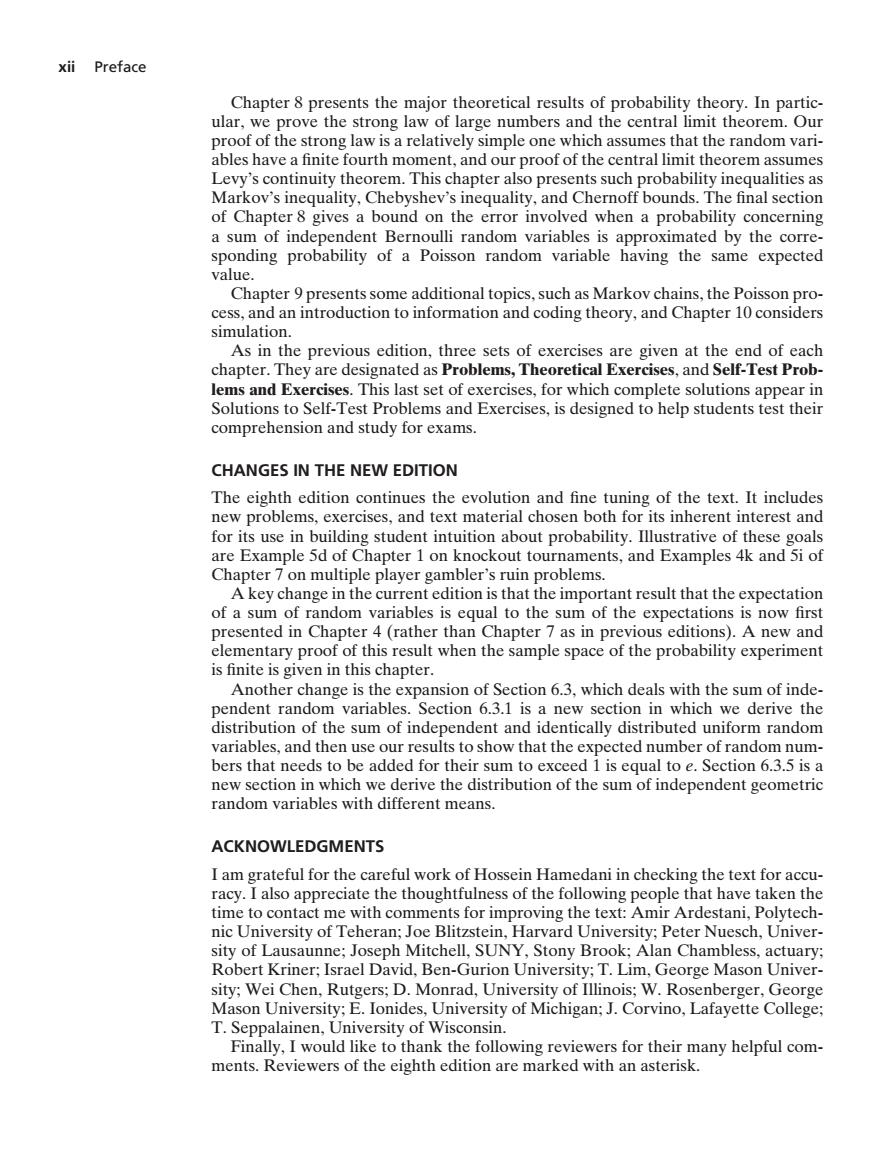正在加载图片...

xii Preface Chapter 8 presents the major theoretical results of probability theory.In partic- roe prove the strong law of laree number nd thean strong lawis a relatively n assumes th Levy's continuity theorem.This chapter also presents such probability inequalities as Markov's inequality,Chebyshev's he final section 01 he sponding probability of a Poisson random variable having the same expected the poi simulation. This last set of exercis for which complete solutions a r in SotionstoSeTestPoblemsamdExercises.sdesignediBheipSudemsteel comprehension and study for exams CHANGES IN THE NEW EDITION The eighth edition continues the evolution and fine tuning of the text.It include new problems, ercises, and text material chosen both fo its inh erent interest ane 公二aw this result when the sample space of the probability experiment napter num er or ran 6.3nm new section in which istooofpndet eome random variables with different means ACKNOWLEDGMENTS me to conta me with comme d sity of Lausaunne:Joscph Mitchell.SUNY.Stony Brook:lan Chambie Robert Kriner:Israel David,Ben-Gurion University;T.Lim,George Mason Univer xii Preface Chapter 8 presents the major theoretical results of probability theory. In particular, we prove the strong law of large numbers and the central limit theorem. Our proof of the strong law is a relatively simple one which assumes that the random variables have a finite fourth moment, and our proof of the central limit theorem assumes Levy’s continuity theorem. This chapter also presents such probability inequalities as Markov’s inequality, Chebyshev’s inequality, and Chernoff bounds. The final section of Chapter 8 gives a bound on the error involved when a probability concerning a sum of independent Bernoulli random variables is approximated by the corresponding probability of a Poisson random variable having the same expected value. Chapter 9 presents some additional topics, such as Markov chains, the Poisson process, and an introduction to information and coding theory, and Chapter 10 considers simulation. As in the previous edition, three sets of exercises are given at the end of each chapter. They are designated as Problems, Theoretical Exercises, and Self-Test Problems and Exercises. This last set of exercises, for which complete solutions appear in Solutions to Self-Test Problems and Exercises, is designed to help students test their comprehension and study for exams. CHANGES IN THE NEW EDITION The eighth edition continues the evolution and fine tuning of the text. It includes new problems, exercises, and text material chosen both for its inherent interest and for its use in building student intuition about probability. Illustrative of these goals are Example 5d of Chapter 1 on knockout tournaments, and Examples 4k and 5i of Chapter 7 on multiple player gambler’s ruin problems. A key change in the current edition is that the important result that the expectation of a sum of random variables is equal to the sum of the expectations is now first presented in Chapter 4 (rather than Chapter 7 as in previous editions). A new and elementary proof of this result when the sample space of the probability experiment is finite is given in this chapter. Another change is the expansion of Section 6.3, which deals with the sum of independent random variables. Section 6.3.1 is a new section in which we derive the distribution of the sum of independent and identically distributed uniform random variables, and then use our results to show that the expected number of random numbers that needs to be added for their sum to exceed 1 is equal to e. Section 6.3.5 is a new section in which we derive the distribution of the sum of independent geometric random variables with different means. ACKNOWLEDGMENTS I am grateful for the careful work of Hossein Hamedani in checking the text for accuracy. I also appreciate the thoughtfulness of the following people that have taken the time to contact me with comments for improving the text: Amir Ardestani, Polytechnic University of Teheran; Joe Blitzstein, Harvard University; Peter Nuesch, University of Lausaunne; Joseph Mitchell, SUNY, Stony Brook; Alan Chambless, actuary; Robert Kriner; Israel David, Ben-Gurion University; T. Lim, George Mason University; Wei Chen, Rutgers; D. Monrad, University of Illinois; W. Rosenberger, George Mason University; E. Ionides, University of Michigan; J. Corvino, Lafayette College; T. Seppalainen, University of Wisconsin. Finally, I would like to thank the following reviewers for their many helpful comments. Reviewers of the eighth edition are marked with an asterisk